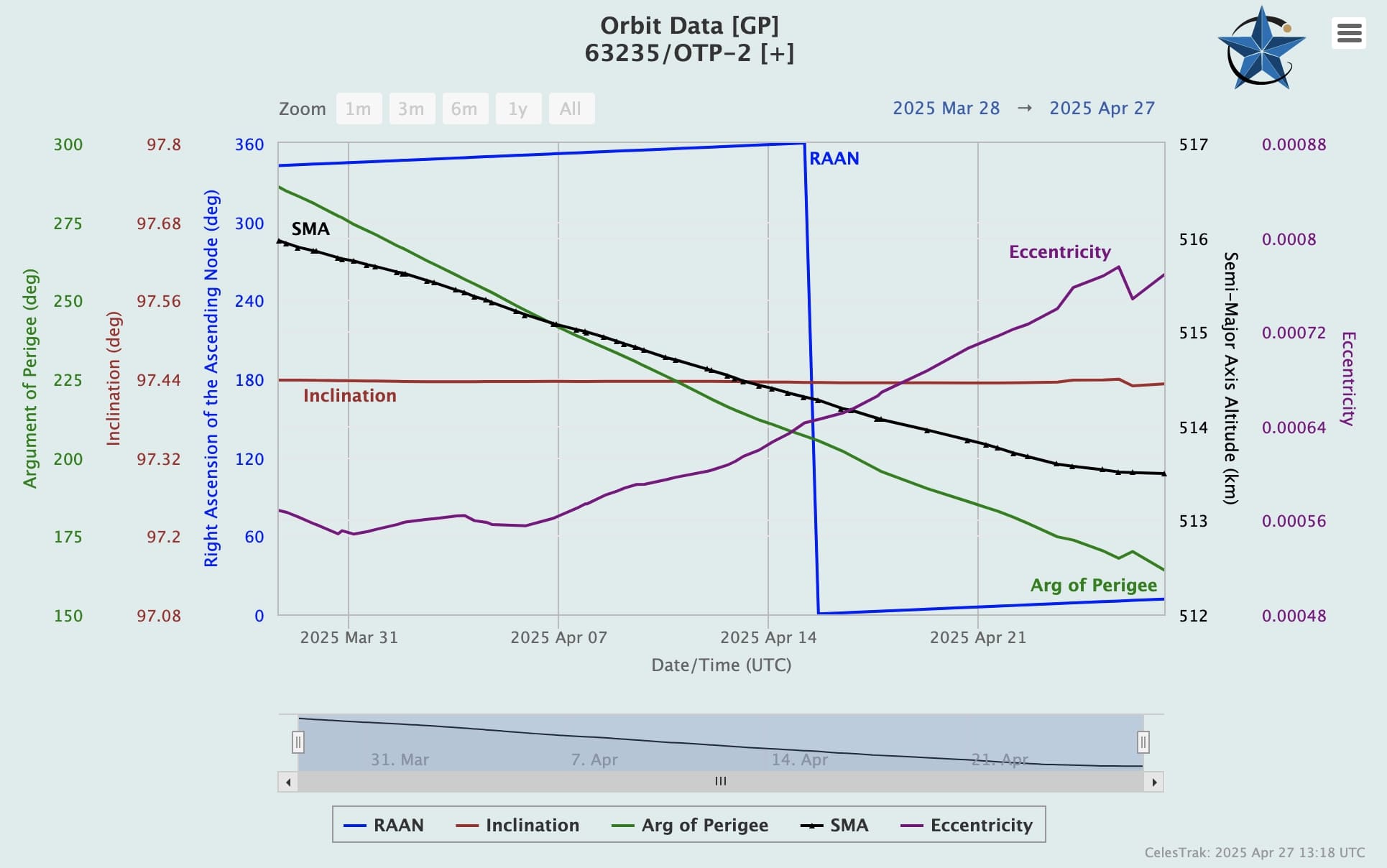Now Reading: OTP-2 Propellantless Drive Satellite Continues to Show a Shallowing Orbital Decline
-
01
OTP-2 Propellantless Drive Satellite Continues to Show a Shallowing Orbital Decline
OTP-2 Propellantless Drive Satellite Continues to Show a Shallowing Orbital Decline

Satellite 63235 is Rogue Space Systems’ OTP-2 satellite and the propellanless drive onboard OTP-2 is IVO’s Quantum Drive. The satellite tracking is continuing to show a shallowing of the orbital decline.
Rogue’s new spacecraft, named OTP-2, will test the company’s on-board computing software and its ability to aggregate data from multiple sensors and process that data in real time. They will test customer payloads from the propulsion startup IVO. The company is developing so-called IVO Quantum Drive electric propulsion technology for low-Earth orbit spacecraft. The Quantum Drive is based on the Quantized Inertia theory. The previous late 2023 Barry-1 satellite with IVO quantum drives had a mundane satellite communication failure that was not related to the new propulsion test.
Quantized Inertia (QI) is a theory of inertia first proposed in 2007 by physicist Mike McCulloch, from the University of Plymouth. The phenomenon of inertia is defined in Newton’s First Law: “Objects move in straight lines at constant speed unless pushed on” but it has never been explained. Quantised inertia explains inertia, for the first time, by combining relativity and quantum mechanics.
According to relativity, an accelerating object will see a Rindler horizon in the direction opposite to that of its acceleration vector. This is because information travels at the speed of light.
Quantized Inertia further predicts that for objects with very low accelerations, such as stars at the edges of galaxies, the Rindler horizon moves so far back that it is close to the cosmic horizon so the waves of Unruh radiation are now damped equally all around, and the mechanism of inertia collapses. This explains why stars at the edge of galaxies can orbit faster than expected but still remain bound to the galaxy. As a result, Quantised Inertia predicts galaxy rotation perfectly without the need for dark matter or any adjustment.
More practically, quantized inertia also predicts that we can get thrust and energy from the vacuum.
An accelerating object will see itself surrounded by so-called Unruh radiation. The horizon splits virtual particles, so that they become real radiation.
Quantized Inertia combines these two predictions by saying that the horizon damps (reduces) the Unruh radiation on one side of the object. The resulting gradient in the quantum vacuum pushes the object back against it acceleration, explaining inertia
They received patent for a capacitor used in the wireless transmission of power, a primary market for IVO’s commercial endeavor that includes the CBAT wireless transmission system currently undergoing strict FCC safety testing for certification, Mansell realized that his facilities were well equipped to do the initial prototyping of drives built using McCulloch’s theories.
Once the drives are turned on, they will either successfully change the orbit of the OTP-2 satellite, rewriting the physics textbooks, or they will fail.
“Our goal is to raise the orbit,” said Mansell. “We would like to do several demonstrations. We’re going to do several orbits of just no thrust whatsoever to get a baseline set of data so we know what the background noise is. And then we’ll turn on the thrusters, the Quantum Drives, and raise the orbit. Then, the goal is to lower the orbit and be able to do this predictably, back and forth, and see if we can change the inclination of the orbit. That would be fantastic.”
McCulloch notes that Newton’s First Law defines inertia with the observation that Objects move in straight lines at constant speed unless pushed on. McCulloch further notes that although Newton defines inertia in these simple terms, the 17th-century genius never quite explains what precisely inertia is.
To explain the true nature of inertia, McCulloch developed his Quantized Inertia (QI) theory, which looks to the strange and mysterious properties of the quantum world for answers. Perhaps unsurprisingly, his efforts to explain inertia have led to wide-ranging criticisms since his proposal seems to defy the laws of motion first set down so many centuries ago, laws that have proven highly reliable for rocket scientists and engineers alike.
This report on the observation of thermal photons from an accelerated electron via examination of radiative beta decay of free neutrons measured by the RDK II collaboration. The emitted photon spectrum is shown to corroborate a thermal distribution consistent with the dynamical Casimir effect. Supported by a robust chi-squared statistic, we find the photons reside in a one-dimensional Planck spectrum with a temperature predicted by the moving mirror model.
“Whether or not the Quantum Drives produce the expected thrust, IVO will have shown again that we are capable of not only trying hard experiments, we can do them efficiently and in record time,” said Mansell, noting that his company was ready to go back in June before a glitch with something else on the satellite caused that flight to be canceled.
“In fact,” he added, “we were able to produce the final flight versions of the Quantum Drives in two months!”

Brian Wang is a Futurist Thought Leader and a popular Science blogger with 1 million readers per month. His blog Nextbigfuture.com is ranked #1 Science News Blog. It covers many disruptive technology and trends including Space, Robotics, Artificial Intelligence, Medicine, Anti-aging Biotechnology, and Nanotechnology.
Known for identifying cutting edge technologies, he is currently a Co-Founder of a startup and fundraiser for high potential early-stage companies. He is the Head of Research for Allocations for deep technology investments and an Angel Investor at Space Angels.
A frequent speaker at corporations, he has been a TEDx speaker, a Singularity University speaker and guest at numerous interviews for radio and podcasts. He is open to public speaking and advising engagements.























